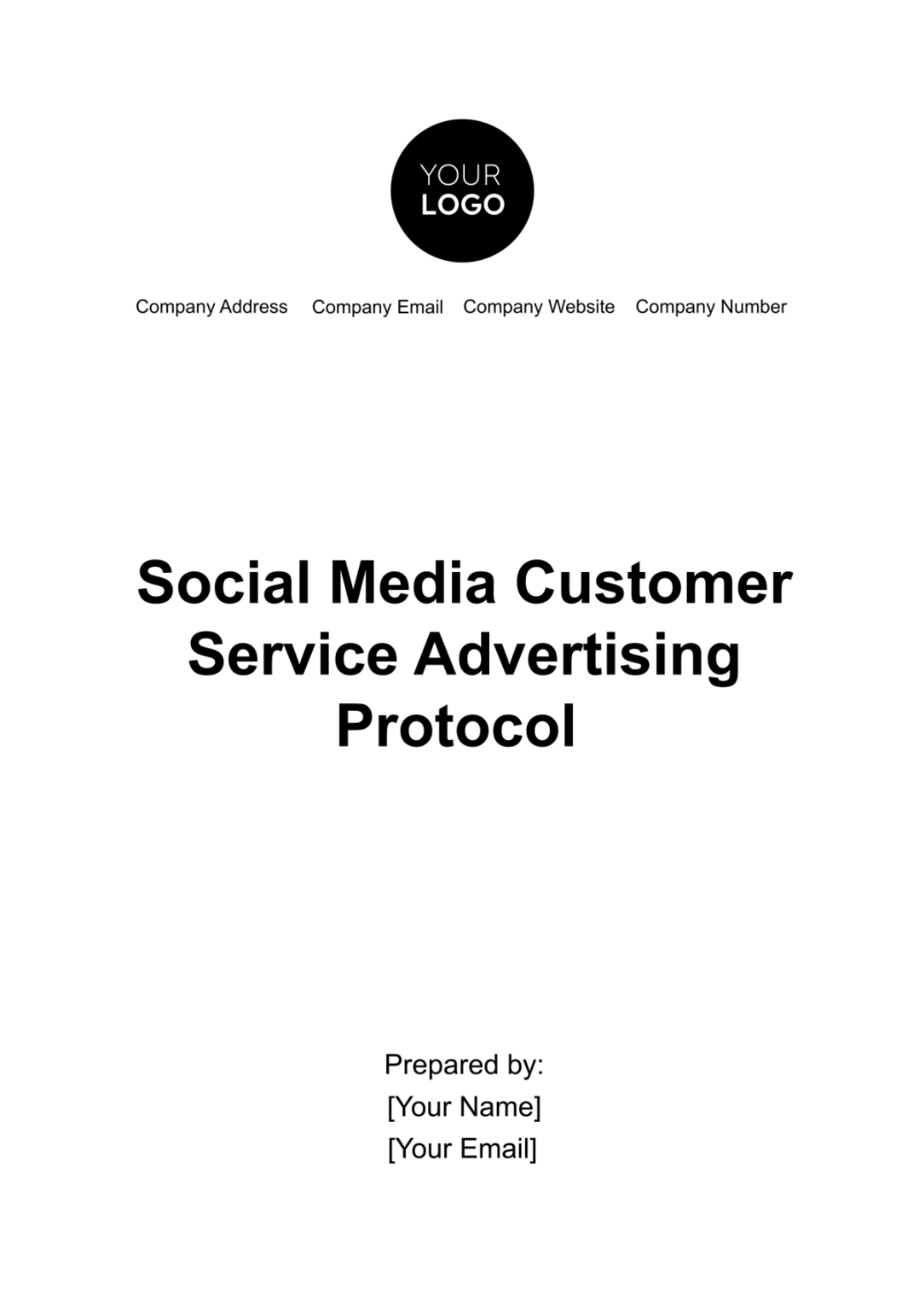Free Social Media Customer Service Advertising Protocol

Introduction
In today's digital age, social media plays a pivotal role in connecting businesses with their customers. As part of our comprehensive social media advertising campaigns, it is essential to establish a clear and effective protocol for managing customer service inquiries on these platforms. This protocol aims to outline specific guidelines, procedures, and best practices for addressing customer inquiries, resolving issues, and ensuring a positive and consistent brand image across all our social media channels.
Social Media Platforms
Our company maintains a strong presence on various social media platforms to engage with our customers and promote our products and services effectively. Below are the platforms we are active on, along with our respective handles or usernames:
Platform | Handle/Username |
@OurCompany | |
@OurCompanyHQ | |
@OurCompanyOfficial | |
@OurCompanyInc |
Responsibilities
A. Social Media Team
Our dedicated social media team plays a critical role in ensuring that customer inquiries are promptly and professionally addressed on all our social media channels. Their responsibilities include:
Continuously monitoring all social media channels during business hours and, when necessary, extending monitoring to after hours.
Acknowledging and responding to customer inquiries, comments, and mentions within a maximum of two hours during business hours and within [00] hours outside of business hours.
Directing customers to appropriate channels for more detailed or sensitive inquiries, such as email or direct messages.
B. Customer Service Team
Our customer service team is instrumental in collaborating with the social media team to address customer inquiries and complaints effectively. Their responsibilities include:
Maintaining close communication with the social media team to stay informed about ongoing interactions and updates.
Providing detailed and accurate information to the social media team to facilitate comprehensive responses to customer inquiries.
Escalating unresolved issues or complex inquiries to the appropriate department within the company, ensuring that customers receive the best possible support.
Response Guidelines
A. General Guidelines
To ensure consistency and professionalism in our responses on social media, we have established the following general guidelines for all team members:
Always respond professionally and courteously, maintaining a positive and customer-centric brand image.
Acknowledge the customer's inquiry promptly, even if the resolution might take longer to achieve.
Whenever possible, use the customer's name when responding, as it personalizes the interaction.
Avoid using industry-specific jargon or technical language; instead, explain concepts and information in a clear and easily understandable manner.
Show empathy towards customers by expressing understanding of their concerns, needs, and feedback.
B. Specific Responses
To address different types of customer interactions effectively, we have outlined specific response strategies:
Questions: Provide accurate and concise answers to customer questions. If more information is needed, request it politely.
Complaints: Apologize for any inconvenience caused and offer practical solutions or next steps to resolve the issue. Ensure that the customer feels heard and valued.
Positive Feedback: Express gratitude for positive feedback and convey appreciation for the customer's support. Encourage them to continue engaging with our brand.
Negative Feedback: Respond professionally to negative feedback or criticism. Address concerns calmly and offer to take the conversation offline to resolve the issue privately, if necessary.
Product or Service Issues: Gather all necessary information about product or service issues and coordinate with the relevant internal departments to expedite problem resolution.
Prize or Promotion Inquiries: Provide clear and concise details about ongoing promotions or contests, and direct customers to the official rules and guidelines when necessary.
Crisis Management
In the event of a social media crisis, such as a sudden surge in negative comments or complaints, the social media team should act swiftly and decisively. Key actions to take during a crisis include:
Immediately inform the designated crisis management team within the organization.
Activate the crisis communication plan, which includes predefined responses, escalation procedures, and communication channels.
Continuously monitor and assess the situation, adapting responses as necessary to mitigate the crisis's impact.
Training
To ensure that all team members are well-prepared to execute this protocol effectively, we emphasize the importance of training and continuous improvement.
All social media and customer service team members must undergo comprehensive training on this protocol.
Periodic refresher courses and workshops will be conducted to ensure that team members stay updated with the latest best practices and techniques for social media customer service.
Regular role-playing and scenario-based training exercises will be employed to sharpen response skills and crisis management capabilities.
Performance Metrics
We measure the performance of our social media customer service efforts using the following key metrics:
Response Time: This metric evaluates the time taken to respond to customer inquiries. Our goal is to maintain a swift response time to enhance customer satisfaction.
Resolution Time: We track the time it takes to fully resolve customer issues. Reducing resolution time is critical in ensuring a positive customer experience.
Customer Satisfaction: We gather feedback and ratings from customers on our social media interactions. High satisfaction ratings indicate effective customer service.
Escalation Rate: This metric helps us identify the rate at which issues are escalated to higher levels of support within the organization. A low escalation rate suggests that most issues are resolved at the first point of contact.
Social Media Content Strategy
Content Relevance: To ensure that our social media content is highly relevant, we employ a content calendar that aligns with our product and service offerings. This calendar includes a schedule of posts, themes, and content types. For instance, during a product launch campaign, our content may consist of teaser posts, behind-the-scenes insights, and user-generated content that highlights product benefits.
Timeliness: Timing is crucial in social media engagement. We've identified peak customer activity hours on each platform and tailor our content posting schedule accordingly. For example, on Twitter, where real-time engagement is key, we post updates, news, and quick responses during peak hours.
Customer-Focused Messaging: Our content strategy emphasizes addressing customer questions and concerns proactively. We maintain a list of frequently asked questions and common pain points to craft content that provides value. For instance, if we notice customers frequently asking about the compatibility of our products with specific operating systems, we create content that explains compatibility and highlights advantages.
Consistency: Consistency is vital in reinforcing our brand identity. We have defined brand guidelines that include tone, style, and visual elements. These guidelines are followed rigorously to maintain a cohesive brand image across all social media channels. For example, we use consistent fonts, colors, and messaging tone in our posts.
Social Media Content Calendar
A well-structured content calendar is the backbone of our social media content strategy. The table below provides an overview of our typical content calendar structure:
Month | Theme | Content Types | Key Dates |
January | Winter Promotions | Product Showcases, | New Year's Specials, |
Customer Testimonials | Winter Sale Launch | ||
Data Privacy and Security
Data Confidentiality: We prioritize the confidentiality of customer information. Our social media team is trained to never share or discuss customer-specific details on public social media channels. Instead, they direct customers to private channels such as direct messages or email for handling sensitive information.
Compliance: Ensuring that all customer interactions on social media align with data protection regulations is a top priority. We stay updated on the latest data protection laws, such as GDPR, CCPA, and HIPAA, to ensure full compliance in our social media interactions.
Secure Communication: To safeguard customer information during private discussions, we use secure communication channels and encryption methods. For example, all private messages and email exchanges are encrypted to prevent unauthorized access to sensitive data.
Data Privacy Compliance Checklist
To maintain a high level of data privacy compliance, we follow a checklist that includes the following key points:
Regularly review and update our privacy policy to align with changing regulations.
Ensure that customer consent is obtained for any data collection or processing activities.
Provide customers with easy-to-access information on how their data is used and how they can exercise their data rights.
Educate our team members on data privacy best practices through ongoing training and awareness programs.
Multilingual Support
Language Availability: Our commitment to providing multilingual support involves having team members who can communicate in languages commonly spoken by our customer demographics. We maintain a database of languages and the team members proficient in each language to ensure swift and accurate responses.
Translation Services: For languages beyond the proficiency of our team members, we employ professional translation services to maintain accuracy and consistency in multilingual interactions. This ensures that our messaging retains its quality and meaning across languages.
Cultural Sensitivity: Team members are trained to be culturally sensitive and respectful in their interactions with customers from different linguistic backgrounds. This includes understanding cultural nuances, customs, and communication styles.
Multilingual Support Matrix
The table below illustrates our approach to multilingual support, detailing languages supported by our team members and those requiring professional translation services:
Language | Supported by Team | Requires Translation |
English | Yes | No |
Spanish | Yes | No |
French | Yes | No |
Chinese (Mandarin) | Yes | Yes |
Arabic | No | Yes |
German | Yes | No |
Social Media Crisis Communication Plan
Predefined Response Templates: During a crisis, time is of the essence. We have developed a library of predefined response templates for various crisis scenarios. These templates provide immediate guidance to our social media team, ensuring timely and consistent messaging. For example, a data breach response template outlines steps to inform affected parties and authorities.
Spokesperson Identification: It's crucial to have clear spokespersons designated for crisis communication. These individuals are trained to communicate with the public during a crisis. We maintain a list of spokespersons, each with their contact details, to ensure swift response and clear communication.
Escalation Procedures: In severe crises, issues may need to be escalated to senior management or legal teams. We've outlined clear procedures for escalating crises, including who to contact, when to escalate, and what information needs to be shared with higher-ups.
Post-Crisis Evaluation: After a crisis is resolved, a thorough post-crisis evaluation is conducted. This evaluation identifies lessons learned, areas for improvement, and potential changes to our crisis response strategies to enhance preparedness for future crises.
Crisis Scenario and Spokesperson Matrix
To streamline crisis communication, we have defined specific scenarios and corresponding designated spokespersons as shown in the table below:
Crisis Scenario | Designated Spokesperson |
Data Breach | Chief Information Officer |
Our Social Media Customer Service Advertising Protocol Document is a comprehensive guide that outlines specific strategies, responsibilities, and best practices for managing customer service inquiries effectively on social media platforms. These expanded sections cover our social media content strategy, data privacy and security measures, multilingual support approach, and the crisis communication plan. By adhering to these detailed guidelines, we can maintain a positive brand image, provide exceptional customer service, and achieve success in our social media advertising campaigns. We remain committed to ongoing improvement and adaptation to meet evolving customer needs and expectations in the digital
- 100% Customizable, free editor
- Access 1 Million+ Templates, photo’s & graphics
- Download or share as a template
- Click and replace photos, graphics, text, backgrounds
- Resize, crop, AI write & more
- Access advanced editor
Unlock unparalleled customer service excellence with Template.net's Social Media Customer Service Advertising Protocol Template. This editable and customizable resource empowers you to establish seamless communication protocols. Tailor it effortlessly in our Ai Editor Tool to suit your brand's unique needs. Elevate your customer experience and streamline your social media interactions today.
You may also like
- Instagram Ad
- Instagram Banner
- Instagram Frame
- Instagram Post
- Instagram Profile Picture
- Instagram Story
- Instagram Story Highlights
- Twitter Ad
- Twitter Header
- Twitter Post
- LinkedIn Photo
- Linkedin Post
- YouTube
- Youtube Ad
- Youtube Banner
- YouTube Channel Art
- YouTube End Screen
- Youtube Profile Photo
- YouTube Thumbnail
- Facebook Ad
- Facebook Cover
- Facebook Post
- Facebook Profile Frame
- Facebook Profile Photo
- Twitch Offline Banner
- Linkedin Banner
- Twitch Overlay
- Whatsapp Status
- Reddit Banner
- Social Media Banner
- Social Media Clipart
- Social Media Plan
- Social Media Contract
- Social Media Planner
- Social Media Report
- Social Media Agreement
- Social Media Business Card
- Social Media Proposal
- Social Media Presentation





























